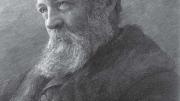Between 1857 and 1950, Frederick Law Olmsted, A.M. 1864, LL.D. ’93, and the firm he founded shaped many of our nation’s notable open spaces, ranging from New York City’s Central Park, the Niagara Falls Reservation, and the U.S. Capitol grounds to the Berkeley and Stanford campuses and the landscaping of Harvard-affiliated McLean Hospital (he chose its site, in Belmont, Massachusetts, in 1872, and returned there, as a patient, in old age). Yet Olmsted experienced a prolonged vocational identity crisis. He was a businessman, a scientific farmer, a merchant seaman, an anti-slavery writer, a newspaper and magazine correspondent (he cofounded the Nation): as he wrote, “a loitering, self-indulgent, dilettante sort of man.” Two fortuitous events helped clarify his life’s work, which became clear to him only at the age of 35.
The first occurred in Liverpool, England, in 1850. Olmsted was savoring the fare in a bakery when the proprietor suggested a visit to the nearby Birkenhead Public Park. Joseph Paxton, the future architect of London’s Crystal Palace, had transformed 120 acres of flat, clay farmland by digging a lake and using the excavated earth to create hills, meadows, shady glens, overgrown hillocks, and footpaths that meandered through clumps of leafy trees. The results captivated Olmsted: “It reached a perfection I had never before dreamed of.” In an article for the Horticulturist, he detailed the underground drainage system that fed water to the lake, noted the artful composition of the winding paths, and bemoaned the absence of comparable parks in his native United States. This text, in which he discussed the impact of landscape architecture on the human psyche—“a feeling of relief from the cramped, confined, and controlling circumstances of the street and the town”—was Olmsted’s earliest published psychoarchitectural statement.
Six years later, in a New Haven resort, Olmsted met one of the commissioners planning Central Park and learned that the post of construction superintendent was open. Realizing that he could incorporate Paxton’s principles into the plan, he applied and was chosen for the job, partly because of his Horticulturist article.
His success in this, his first major public work, left him overjoyed that he had found his calling. “If a fairy had shaped it for me,” he wrote, “it could not have fitted me better. It was normal, ordinary, and naturally outgrowing from my previous life history.”
That prior history, we now know, was trauma-ridden. Indeed, it seems possible that both his prolonged search for fulfilling work and his ultimate vocation stemmed from an accumulation of tragedies. The primary shock was his mother’s fatal overdose of laudanum after a prolonged postpartum depression. Olmsted described the experience in an undated fragment:
When I was three years old I chanced to stray into a room at the crisis of a tragedy therein occurring, and turned and fled from it screaming….It was long before I could be soothed and those nearby said to one another that I would never forget what I had seen.
Evidence suggests that he developed severe posttraumatic stress disorder, a condition reinforced 14 months later when his father married a woman who largely banished the boy from home. Relegated to the care of a succession of teachers and rural clergymen, Olmsted endured further traumas. When he was seven, a teacher whose clothes caught fire burned to death. When he was 10, a stepsister died from measles. Between the ages of nine and 14, he boarded with a pastor who physically abused his pupils.
For escape, Olmsted frequented the woods.
My mother died while I was so young that I have but a tradition of memory rather than the faintest recollection of her. While I was a small school boy, if I was asked if I remembered her, I could say ‘Yes; I remember playing in the grass and looking up at her while she sat sewing under a tree….’ [I]t has always been a delight to me to see a woman sitting under a tree, sewing and minding a child.
It is not far-fetched to suppose that Olmsted came into his calling because he sought with every fiber of his being to realize that vision. By introducing nature to the urban scene, he offered respite from the pathogenic influences of city life, “the symptoms of which,” he wrote, “are nervous tension, over-anxiety, hasteful disposition, impatience, [and] irritability.” Such symptoms could be reversed through exposure to pleasing rural scenery: “It is thus, in medical phrase, a prophylactic and therapeutic agent of value….”
In a tragic irony, Olmsted had to be hospitalized, at McLean, for the last five years of his life. His medical record is sealed, but whatever the problem, it undoubtedly exacerbated the earlier posttraumatic stress disorder. He was alert enough, nevertheless, to note that certain of his concepts had been disregarded in the hospital-grounds construction: he complained to a family member, “They didn’t follow my plan, confound them!”
If the art of living is the ability to use life’s inevitable adversities constructively, it could be said that many of us are the beneficiaries of Olmsted’s landscape-psychoarchitectural artistry.
Michael Sperber, M.D., trained in psychiatry at Harvard Medical School and is a consultant to McLean Hospital’s Neuropsychiatry-Behavioral Neurology Service. The text is adapted from his forthcoming book, “Dostoyevsky’s Stalker: Essays on Psychopathology and the Arts” (Provincetown Arts Press, 2008).






